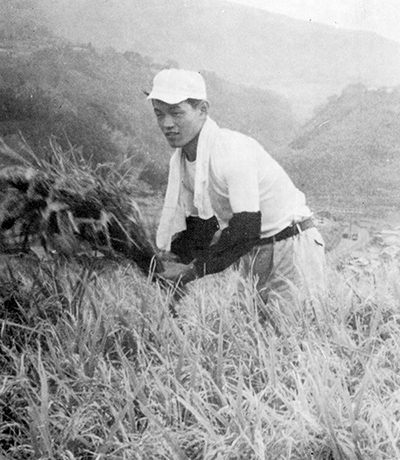An era of unprecedented economic growth began in the mid-1950s. This included the so-called “Jinmu Boom” from 1956 to 1957, driven by increased private-sector investments in capital equipment. The chemical fiber industry made a series of investments centering on viscose rayon. Around this time, the catchphrase “We’re no longer postwar” caught on.
However, the boom didn’t last very long. The government adopted a policy of monetary tightening to improve the balance of international payments. The fiber industry was hit especially hard since we had just expanded our viscose rayon plants to a great degree. In August 1957, it reached the point where the Ministry of International Trade and Industry recommended reducing operation rates by 20% on average.
The viscose rayon market still didn’t recover, and in January 1958 the Ministry called for further reduction of operation to 50%. That was the bottom of the rayon slump, and fiber companies called for voluntary redundancies, amounting to more than 8,000 employees across the industry.
 Plant leader bidding farewell ahead of a furlough
Plant leader bidding farewell ahead of a furlough
Asahi Kasei also suffered terribly from the rayon slump and we ended up with many surplus employees. As the person in charge of labor affairs, I really wanted to avoid voluntary redundancies. Just when we were finally building trust between labor and management after the Nobeoka dispute, it would have been unbearable to let go of the workers who had helped us.
But the business environment was so bad that we couldn’t just keep all of those surplus employees. I thought we could ride out the emergency by giving furloughs. The surplus employees would be temporarily out of work, but they could receive unemployment insurance and then gradually be brought back once we overcame the difficult situation.
I negotiated with the unions, who understood the company’s distress and agreed to the proposal on the condition that the employees could get their previous jobs back. The first group of 175 workers were relieved in September 1957 and the second group of 186 in October.
The problem was that the Ministry of Labor said, “Unemployment insurance is not applicable to those furloughed for a limited period of time.” This was a hard nut to crack, but there was no way we could stop the furloughs. I gave it a lot of thought and finally asked the unions to have the employees resign in form only, as we promised that they could return after some time.
The unemployment insurance wouldn’t be applicable otherwise, including if we promised to rehire them in writing. There was no choice but to have them resign and simply trust the company’s verbal promise.
The furloughed workers must have been anxious. But this was the only way to save the company without resorting to layoffs. I hated it too, but asked the unions to somehow accept this proposal.
I was afraid they might reject it, but following repeated discussions among the unions, they accepted it. I was happy because I thought, “That’s how much they trust the company.” I swore in my heart that I would absolutely keep that promise so as not to betray the union members’ trust.
In January 1958, 1,142 workers resigned with only a verbal promise. I spoke with the unions and we decided that someone from the Labor Department and someone from the unions would be sent to visit the furloughed workers once a month. We wanted to alleviate their anxiety as much as possible by providing them reports on the company’s situation. We sent people not just all over Kyushu but also across western Japan.
We also had a hard time deciding who to furlough. It would worry those furloughed if we kept all the best workers and sent away the less outstanding ones. Although the company wanted to keep the best workers, we decided to let them go. It wasn’t until July 1958 that all the furloughed workers came back.
This really solidified the cooperation and mutual trust between labor and management that had developed since the Nobeoka dispute.
 Temporary leave to help the family business,
Temporary leave to help the family business,
Nobeoka 1957

